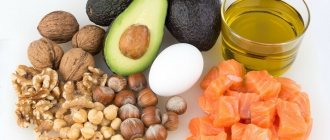General information about unsaturated fats
Unsaturated fats are triglycerides of fatty acids, which include 3 different types of acid residues. Their main sources are seafood, vegetable oils, nuts, and oilseeds.
Chemical structure
In molecules there is at least 1 double bond between carbon atoms.
Trans or cis isomers are formed in fat molecules. In the first case, the hydrogen atoms are located on opposite sides of the carbon bond, so a rigid structure is formed. To melt such substances, high temperatures are required. Most healthy fats have a cis configuration. It involves placing hydrogen on one side of the carbon skeleton, which causes the molecule to bend. Such molecules have a less stable structure and are more susceptible to catabolism. A large number of double carbon bonds leads to rapid oxidation of the substance.
Being in nature
Vegetable oil is considered the main source of omega-9. The product is obtained from oilseeds: rapeseed, sunflower, olive tree. Sometimes oily liquid is a by-product during the processing of industrial plants (flax, cotton, mustard). Monounsaturated fatty acids (MUFAs) are found in nuts, avocados and seeds. Omega-3 and omega-6 are found in ocean and sea fish. They are found in caviar, eggs, chicken meat, and grape seeds.
Omega-9 is found in many types of vegetable oil.
Trans fats
Trans fats are considered by many doctors to be the worst type of fat we get from food. Unlike other fats, trans fats increase levels of low-density lipoprotein (LDL), the “bad” cholesterol, and lower levels of high-density lipoprotein (HDL), the “good” cholesterol.
- Low density lipoproteins (LDL). LDL, or “bad” cholesterol, can build up in the walls of your arteries, making them stiff and narrow.
- High density lipoproteins (HDL). HDL, or “good” cholesterol, helps remove excess cholesterol from the body.
In turn, the combination of high LDL cholesterol and low HDL cholesterol increases the risk of developing heart disease. Various studies show that trans fats can be harmful to health even in small amounts: for every 2% of trans fat calories consumed per day, the risk of heart disease increases by 23%.
Trans fat is a byproduct of a process called hydrogenation, which is used in the production of solid oils. Vegetable oil undergoes a process of hydrogenation, which converts vegetable oils into solids. The use of hydrogenated oils in production allows you to increase the shelf life of products. Some restaurants use hydrogenated vegetable oil in their fryers, which allows for more frying.
Trans fats, known as partially hydrogenated oils, are found in a variety of foods, including:
- Bakery products: cakes, cookies, crackers
- Snacks: chips, popcorn, canned food
- Dishes that require deep frying - French fries, donuts, fried chicken
- Ready dough
- Cream and margarine
When reading food labels, check the list of ingredients. The presence of partially hydrogenated vegetable oil indicates that the food contains trans fats.
Effect on the human body
Polyunsaturated acids are necessary for the functioning of membranes, organ membranes, and connective tissue. They ensure normal fetal development, prevent fat accumulation, and reduce the concentration of stress hormones.
Critical for fetal development during pregnancy
Taking omega-3 and omega-6 is important in the first and third trimesters, as they prevent the occurrence of pathologies in the fetus. They maintain normal blood circulation in the placenta so that the baby receives the necessary vitamins, amino acids, and minerals. Docosahexagenic acid is responsible for the formation of brain matter and vision development in a child.
Children who receive the required amount of polyunsaturated fats are distinguished by more developed motor skills, coordination, and intellectual abilities.
Reduce blood pressure
The hypotensive effect is achieved due to the formation of prostaglandins, which affect vascular tone. The amount of adenosine in the brain decreases. Polyunsaturated fats help reduce the level of stress hormones in the blood and the concentration of calcium ions in cells. As a result of these processes, the elasticity of blood vessels improves. They expand, so blood pressure normalizes.
Reduce triglyceride levels in the blood
PUFAs regulate fat metabolism in the body. They slow down the synthesis of triglycerides and lipoproteins and prevent them from accumulating in adipose tissue. It is enough to consume about 4 g of fish oil every day to reduce the level of these organic substances in the blood by 25-35%.
PUFAs reduce the concentration of triglycerides in the blood.
Improves depression and ADHD
Omega-6 and omega-3 have positive effects on people with attention deficit hyperactivity disorder (ADHD). These substances reduce the frequency of symptoms of the disease by 25% and alleviate them. They control serotonin levels, therefore reducing the risk of depression. But the best effect is observed when combining essential fats with antidepressants.
How much fat is there?
Nutritionists recommend consuming a total of 65 grams of fat per day, or 30-35% of total calories. Make sure these fats are polyunsaturated fatty acids: Omega-3 (ALA, DHA and EPA) or monounsaturated fats.
Try to stick to foods that have low levels of saturated fat and do not contain trans fats (partially hydrogenated oils). The easiest way to do this is to reduce your intake of the main sources of unhealthy saturated fat: hamburgers, pizza, meat, and foods fried in vegetable oil or partially hydrogenated oil.
Remember, fats have more calories than protein and carbohydrates. Therefore, it is better to consume them little by little throughout the day.
Foods containing unsaturated fats
The main source of polyunsaturated acids is fish and seafood. Monounsaturated fats predominate in vegetable oils and oilseeds.
Fish
Fish is a rich source of omega-3. In different types, the content of this substance is (in g per 50 g serving):
- salmon - 1.29;
- herring - 1.21;
- mackerel - from 0.81 to 1.34;
- tuna - 0.82;
- sardines - 0.74;
- trout - 0.53;
- cod - 0.11.
Omega-3 content in different types of fish.
Red and black caviar are characterized by a high concentration of PUFAs (4 g per 50 g of product). The amount of nutrients depends on the habitat of the fish. Marine species that feed on algae are rich in alpha-linoleic acid and contain some omega-6. But in river varieties, the concentration of the latter increases by 13-15 times, and eicosapentaenoic alpha-linoleic acid is less.
Seafood
Seafood is a good alternative to fish in your diet, as it contains a lot of polyunsaturated fats. The leaders in their quantity are considered to be oysters, conger eel, shrimp, scallops, and clams. Additionally, they contain some omega-6 acids.
Vegetable oils
They are dominated by linoleic and arachidonic acids. More of these fats are concentrated in the unrefined product. The following oils have a high concentration of these substances (in g per 50 g of liquid):
- poppy - 36.4;
- sunflower - 30.5;
- hemp - 26.4;
- soybean - 25.7;
- cotton - 25.4;
- sesame - 20.
Fat content in unrefined oils.
Unrefined olive oil contains omega-9 acids (38.7 g). The flax-based product stands out especially. It is high in alpha-linoleic acid (about 28 g) and low in other unsaturated fats.
Nuts and oil seeds
When consuming nuts daily, the body receives a portion of omega-6 and omega-9 acids. The former are found in walnuts and pine nuts, pecans, peanuts, and pistachios. Macadamia nuts, hazelnuts, almonds, and cashews are considered rich in monounsaturated fats. Among oilseeds, the highest concentration of these substances is typical for sunflower seeds and sesame. Some PUFAs are found in cotton seeds, rapeseed, flax, pumpkin, mustard and soybeans.
Meat and eggs
Raw chicken yolk is considered a source of fatty acids. These beneficial substances are found in duck, goose, and quail eggs. Meat contains little of them. Healthy fats are present in rabbit, pork, goose and chicken. Foie gras, duck, lamb, and veal include MUFA.
Polyunsaturated fats are found in turkey skin, beef brisket and brain.
Vegetables
They are not rich in fatty acids. There are no monounsaturated fats in vegetables. A small amount of PUFAs (up to 0.3 g per 100 g) is found in ginger, corn, garlic, broccoli, kale, Brussels sprouts and cauliflower. Some of these substances are present in greens (quinoa, arugula, chives, watercress, parsley).
Health benefits of monounsaturated fats
Eating foods rich in monounsaturated fats has numerous beneficial effects on the human body. The main benefits of MUFA are as follows:
Protects against heart disease
The most well-documented benefit of consuming monounsaturated fats is their beneficial effects on cardiovascular health, especially when reducing intake of saturated fat-rich foods and increasing intake of MUFA-rich foods. Increasing the level of monounsaturated fat in the diet has a protective effect against metabolic syndrome, a group of disorders that increase the risk of developing cardiovascular disease.
In one study published in the Journal of Nutrition, researchers focused on the occurrence of atrial fibrillation (a common type of arrhythmia associated with decreased blood flow to the heart) in women with cardiovascular disease. The findings suggest a link between eating healthy fats and a reduced risk of developing atrial fibrillation.
The researchers also found that diets high in monounsaturated fats had a positive effect on children with high cholesterol and other risk factors for heart disease—even more so than diets high in PUFAs.
The presence of monounsaturated fats in the diet is also important due to the fact that they have anti-inflammatory properties, which helps improve the overall health of the body. Since inflammation is at the root of most diseases, incorporating any inflammation-reducing foods into your diet will increase your ability to prevent the development of common diseases and maintain appropriate levels of health throughout your life.
Improves insulin sensitivity and helps the body use its fat correctly
Another factor contributing to the deteriorating health of populations in much of the developed world is the prevalence of insulin resistance. Insulin resistance is a condition that affects all age groups of people over the age of 18 and is characterized by the body's inability to process and release insulin at the required levels. This causes a buildup of glucose in the blood and often leads to type 2 diabetes.
Weight loss and regular exercise can help reduce insulin resistance. However, there are also specific dietary changes that need to be made to improve insulin sensitivity, such as reducing your intake of saturated fats and increasing your intake of monounsaturated fats.
The root cause of insulin resistance is dysfunction of adipose tissue. Fat tissue serves a purpose by maintaining triglyceride levels in the body when you consume more calories than you need at that very moment. It then releases this energy during fasting as free fatty acids and glycerol. During this process, adipose tissue secretes large amounts of peptides (amino acid compounds) that have a major positive effect on the brain, liver and skeletal muscles, maintaining their homeostasis and maintaining metabolic rates.
When the body experiences fat dysfunction, fat cells are unable to release adequate amounts of peptides and fatty acids, causing insulin resistance and decreased ability to maintain normal body weight. This is most often experienced by people who are overweight or have too little body fat.
The good news is that replacing saturated fat in your diet with monounsaturated fat not only improves insulin sensitivity, but also reverses fat dysfunction. In fact, these fats have a positive effect on fat dysfunction even in cases of obesity. This is why monounsaturated fats can be so effective in weight loss.
Help you lose weight
Diets high in MUFA are not only beneficial for weight loss due to their effects on fat dysfunction. Eating foods rich in monounsaturated fats has been shown to help patients with elevated levels of certain liver enzymes (a precursor to liver disease) reduce weight, waist circumference, and blood cholesterol, among other factors associated with obesity.
Other studies have examined the ability of MUFAs and PUFAs (in various combinations) to help subjects lose weight. Scientists found that a concentration of 60% monounsaturated fat, with a ratio of 1:5 saturated to unsaturated fat, showed the highest level of reduction in body fat and the ability to prevent further accumulation of body fat.
Improves mood
Eating foods rich in monounsaturated fats has a positive effect on your mood. Replacing saturated fats with monounsaturated fats in your diet can reduce irritability, as well as increase your level of physical activity and resting energy expenditure—meaning you burn more calories even when you're resting.
A study conducted at the University of Las Palmas de Gran Canaria in Spain, focusing specifically on depression, found an inverse relationship between a diet high in MUFA and PUFA and the risk of developing depression. Studying more than 12,000 candidates who did not initially suffer from depression, the researchers found that high levels of mono- and polyunsaturated fats in the diet were associated with lower rates of depression, and consuming high amounts of dangerous trans fats was associated with the development of mental disorders.
This may be caused, in part, by the activation of dopamine in the body. Dopamine must be activated in order for you to feel the emotions of satisfaction and happiness. High levels of only saturated fat in the diet inhibit the activation of dopamine, which prevents feelings of happiness and satisfaction in the brain. This is why you need to make sure you have enough MUFAs and PUFAs in your diet, especially if you are prone to developing depression.
Strengthen bones
Monounsaturated fats also allow your bones to absorb calcium efficiently, resulting in increased bone density and a reduced risk of developing brittle bones and diseases such as osteoporosis. Conversely, diets high in saturated fat and low in unsaturated fat are associated with lower bone density and decreased calcium absorption.
Reduce the risk of developing cancer
For decades, experts have studied the relationship between high-fat diets and cancer risk. Although some studies have been inconclusive, much recent evidence supports the hypothesis that a diet high in fat, especially unsaturated fat, helps reduce the risk of developing some types of cancer. Thus, foods high in MUFA are potentially anti-cancer foods.
In the case of endometrial cancer, all three common types of healthy fats have been studied. It is interesting to note that saturated and monounsaturated fats were inversely correlated with the risk of developing this type of cancer, while polyunsaturated fats had no significant correlation. Of these two fats that help reduce the risk of endometrial cancer, MUFAs were associated with the greatest reduction in this risk.
Diets high in monounsaturated fat have been the subject of surveillance in relation to hepatocellular carcinoma (HCC), a form of liver cancer. HCC is a very understudied cancer, especially in terms of how diet influences potential risk factors. However, in a study over an 18-year period published in the International Journal of Cancer, it was found that a diet high in MUFA was associated with a reduced risk of HCC, while diets high in saturated and polyunsaturated fats and There was no reduction in the risk of developing HCC.
Another, perhaps the most controversial topic of research in this area is the connection between reducing the risk of breast cancer and MUFA consumption. Some experts argue that high amounts of monounsaturated fat in women's diets may reduce the risk of breast cancer, but not all scientists agree and the evidence is still limited.
In one June 2021 study, researchers looked at how consuming different types of fat during adolescence affected the breast density of developing girls. High breast density increases the risk of developing breast cancer in the future by four to five times, so it can be an important indicator of potential problems in the future.
The researchers looked at what types of fats and how much the girls consumed as teenagers, and then measured their breast density 15 years later. A fairly high correlation was found in women who consumed high amounts of monounsaturated fat. It was noted that these women had quite low breast density, which is a good indicator that they have significantly reduced their risk of breast cancer.
Daily requirement
The daily intake of these substances depends on the state of health, work activity and place of residence. For a healthy person, it is enough to consume from 50 to 80 g of unsaturated fats (20% of all calories).
Daily intake of healthy fats.
In case of exhaustion or illness, their amount is increased to 100 g. For those living in the middle latitudes of Russia, the daily requirement increases to 30%, in the North - to 40% of the calorie intake. If a person’s work involves heavy physical labor, the share of these substances in the diet should be at least 35%.
Saturated fats
Saturated fats remain solid at room temperature. Sources of saturated fat include red meat, whole milk, cheese, coconut oil, many commercially prepared baked goods, and other foods.
The word "saturated" here refers to the number of hydrogen atoms surrounding each carbon atom. If the chain of carbon atoms contains as many hydrogen atoms as possible, it is a saturated fat.
Foods rich in saturated fats increase total cholesterol and tip the balance towards the more harmful LDL cholesterol, which causes the formation of atherosclerotic plaques in blood vessels. For this reason, most nutritionists recommend limiting saturated fat to less than 10% of calories per day.
Signs of a lack of unsaturated fats in the body
With a lack of plant-based foods in the diet, a deficiency of unsaturated fats occurs. The following symptoms indicate a problem:
- slowdown in physical development;
- growth retardation;
- increased blood cholesterol levels;
- weight loss;
- violation of water metabolism;
- neutralization of the effect of vitamins B and C;
- failure in the exchange of tocopherol and retinol.
Due to the lack of these substances, the skin becomes dry, itching and flaking appear. The condition of hair and nails worsens. Redness and dry eyes are often observed. A person’s mood constantly changes, and he quickly feels tired and hungry.
Reduces inflammation
A diet high in monounsaturated fats helps:
- Reduce inflammatory processes;
- Activates the immune system;
- Helps your body fight infections.
Too much inflammation in the body can contribute to the development of chronic diseases, as well as obesity and heart disease.
A 2004 study published in the Journal of the American College of Cardiology reported that a traditional Mediterranean diet helped reduce inflammation and blood clotting. This explains the beneficial effects of this diet on the cardiovascular system.
So how much does it weigh in grams?
The answer, as always, is simple and clear: it depends on the circumstances.
To begin with, you can take this guideline: saturated fat should account for about 10% (or less) of daily calories [14].
For example, if you estimate your calorie intake to be 2,000 calories, then saturated fat will account for approximately 200 calories—or 22.2 grams.
Here's how to get them: • 200 grams beef = 12 grams saturated fat • 30 grams cheddar cheese = 6 grams saturated fat • 3 large eggs = 5 grams saturated fat = 23 grams saturated fat
Or: • 170 grams salmon = 5 grams saturated fat • 1 tablespoon coconut oil = 12 grams saturated fat • 1 avocado = 4 grams saturated fat = 21 grams saturated fat
As you can see, gaining this 10% is not so difficult. And it’s easy to overdo it if you choose fattier pieces and also like to cook with palm, coconut or butter.
However, we advise you not to get hung up on the numbers, but instead focus on the following four points.
Boosts Heart Health
Eating a diet rich in monounsaturated fatty acids has a beneficial effect on heart function.
A study on atherosclerosis published in 2002 shows that high intake of monounsaturated fat helps reduce coronary risk. Additionally, diets high in MUFA lower blood pressure. In particular, oleic acid is easily absorbed into the body and lowers blood pressure.
A 2005 study of 164 people with high blood pressure found that a diet including monounsaturated fats lowered blood pressure, improved lipid levels and reduced estimated cardiovascular risk compared with a diet without fat. This study was published in JAMA.











